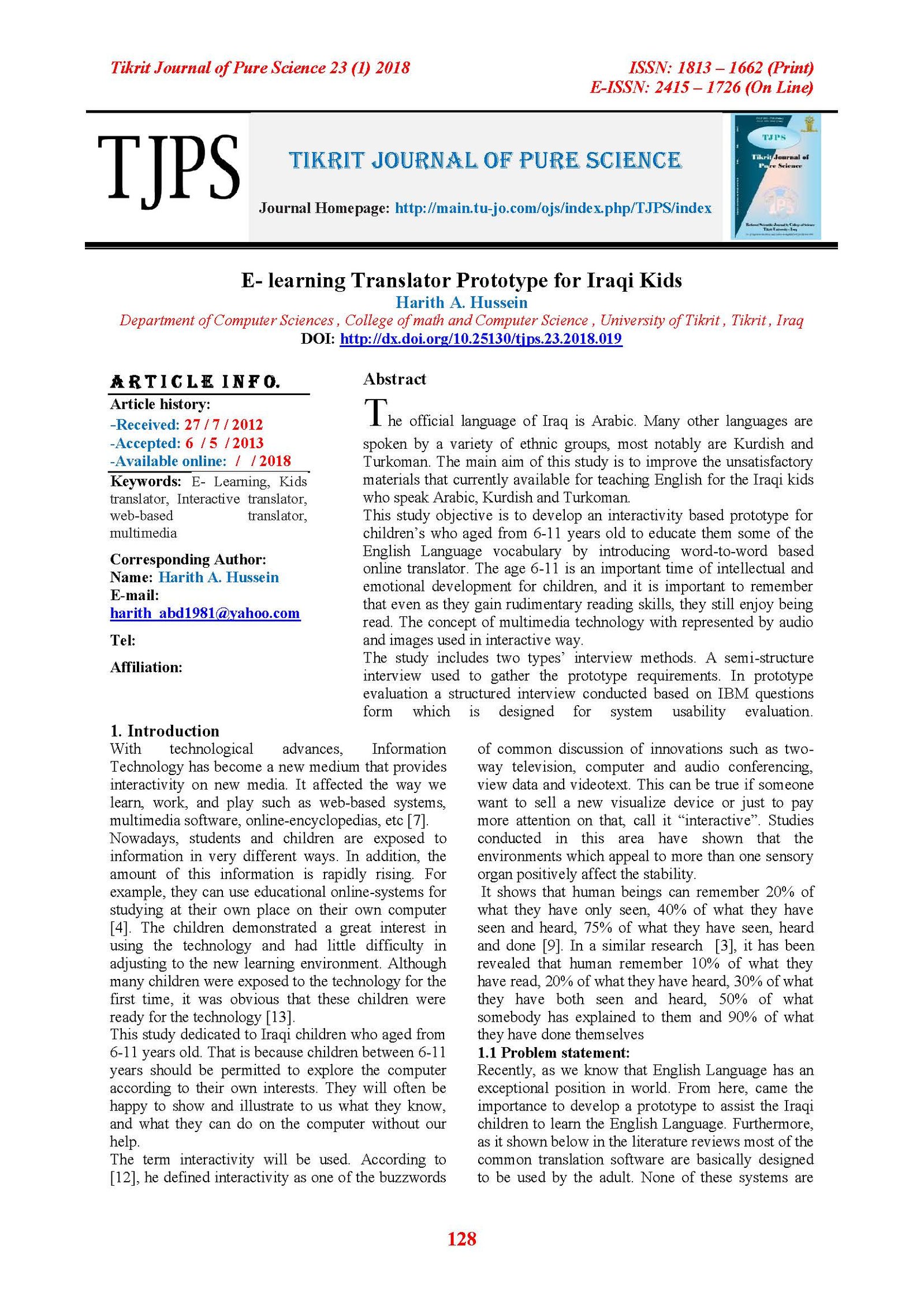E- learning Translator Prototype for Iraqi Kids
Main Article Content
Abstract
The official language of Iraq is Arabic. Many other languages are spoken by a variety of ethnic groups, most notably are Kurdish and Turkoman. The main aim of this study is to improve the unsatisfactory materials that currently available for teaching English for the Iraqi kids who speak Arabic, Kurdish and Turkoman.
This study objective is to develop an interactivity based prototype for children’s who aged from 6-11 years old to educate them some of the English Language vocabulary by introducing word-to-word based online translator. The age 6-11 is an important time of intellectual and emotional development for children, and it is important to remember that even as they gain rudimentary reading skills, they still enjoy being read. The concept of multimedia technology with represented by audio and images used in interactive way.
The study includes two types’ interview methods. A semi-structure interview used to gather the prototype requirements. In prototype evaluation a structured interview conducted based on IBM questions form which is designed for system usability evaluation.
Article Details

This work is licensed under a Creative Commons Attribution 4.0 International License.
Tikrit Journal of Pure Science is licensed under the Creative Commons Attribution 4.0 International License, which allows users to copy, create extracts, abstracts, and new works from the article, alter and revise the article, and make commercial use of the article (including reuse and/or resale of the article by commercial entities), provided the user gives appropriate credit (with a link to the formal publication through the relevant DOI), provides a link to the license, indicates if changes were made, and the licensor is not represented as endorsing the use made of the work. The authors hold the copyright for their published work on the Tikrit J. Pure Sci. website, while Tikrit J. Pure Sci. is responsible for appreciate citation of their work, which is released under CC-BY-4.0, enabling the unrestricted use, distribution, and reproduction of an article in any medium, provided that the original work is properly cited.
References
[1] Adiele, C., Adiele, C. E., & Rana, M. (2006). Web Interact: An e-Learning Support System. Paper presented at the Web Intelligence and Intelligent Agent Technology, Hong Kong. [2] Bass, R. (2003). A brief guide to interactive multimedia and the study of the United States. Retrieved January 15, 2009, from www.georgetown.edu/faculty/bassr/multimedia.html [3] Dumciene, A., Daukilas, S., & Sipaviciene, S. (2008). Axiological logic in the means of e-teaching product interactivity. Paper presented at the Information Technology Interfaces, Dubrovnik. [4] Garrison, D. R., & Anderson, T. (2008). E-Learning in the 21st Century: A Framework for Research and Practice: Falmer Press. [5] Hoffer, J. A., George, J. F., & Valacich, J. S. (1999). Modern systems analysis and design: Addison-Wesley Reading, Mass. [6] Hudetz, W., & Friedewald, M.(2010). Multimedia Product Documentation - User Requirements. Idaho State University. ADDIE - Design. Retrieved January 18, 2009 [7] Mayer, R. E.(2001). Multimedia Learning. United States: Cambridge University Press. [8] Neo, M., & Neo, K. T. K. (2011). Innovative teaching: Using multimedia in a problem-based learning environment. Journal of Educational Technology & Society, 4(4), 19-31. [9] Nunamaker Jr, J. F., & Chen, M. (2009, 2-5 Jan). Systems development in information systems research. Paper presented at the System Sciences, Kailua-Kona, HI, USA. [10] Pahwa, A., Gruenbacher, D. M., Starrett, S. K., & Morcos, M. M. (2009). Distance learning for power professional: IEEE power & energy magazine. [11] Rafaeli, S. (2008). Interactivity: From new media to communication. Journal of Sage Annual Review of Communication Research: Advancing Communication Science, 16, 110-134. [12] Selay Arkün, & Buket Akkoyunlu. (2008). A Study on the development process of a multimedia learning environment according to the ADDIE model and students’ opinions of the multimedia learning environment. Journal of Interactive Educational Multimedia, 1-19. [13] Vaughan, T. (2006). Multimedia: Making it Work (seventh ed.): McGraw-Hill Osborne. [14] White, C. (2011). Distance learning of foreign languages. Journal of Language Teaching, 39(04), 247-264. [15] wikipedia.(2012). History of multimedia. Retrieved November 29, 2008, from http://en.wikipedia.org/wiki/Multime
